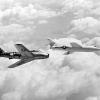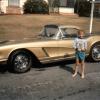Air brakes on the 1955 Mercedes 300SLR
#1

Posted 11 June 2004 - 06:52
In the ‘55 part of the film the 300SLR’s are focused, since they where the main rivals to Jaguar. The terrible accident that caused Mercedes to withdraw from the race has been thoroughly discussed on this forum earlier.
In the film one can see the air brake on the 300SLR’s in operation. A huge flap elevated into the air behind the driver. It was said in the film that the air brake was installed to save the drum brakes, and compensate for the disadvantage for not having disk brakes like Jaguar.
The flap seemed to close rather slowly. It took several seconds form the closing process started. The air brake may saved the drum brakes, but must have been a disadvantage when the car started accelerating to gain speed again.
I have a few questions I hope the experts on this forum can answer (or maybe the Technical Forum is the right place)
How was air brakes operated: by hydraulic cylinders, by electric actuators, or?
Was the operation initiated by the foot pedal, or by a hand switch?
Could the air brake be operated independently from the drum brakes?
Did Mercedes use the air brakes for all of the sports car races in 1955? I have seen a picture of it from the Swedish GP for sport cars, but nothing else.
Has Mercedes been the only manufacturer to use an air brake on a racing car?
The 300SLR was indeed a fascinating car.
best regards
Advertisement
#2

Posted 11 June 2004 - 07:33
Originally posted by Eigar
Did Mercedes use the air brakes for all of the sports car races in 1955?
I don't know about 1955, but in 1952 they tested this device on the 300 SL for LeMans

Copyright: Giorgio Alisi, Ruoteclassiche No.145, December 2000
#3

Posted 11 June 2004 - 09:40
I do not know the answer, but, regarding the nature of the LeMans track with the very high speed Mulsanne straight and the slow corner immediately afterwards, I would expect the system to work independently from the normal brake pedal, and maybe just meant for use at the end of the straiht and perhaps one or two other spots (Dunlop-esses for example).
But these are just suppositions.
mat1
#4

Posted 11 June 2004 - 10:00
A hydraulic pump driven from the back of the transmission provided power for the second electrifying innovation of Le Mans: the air brake.
The 300SLR's air brake worked on a completely different principle than the rooftop brake that had appeared so dramatically and briefly in practice at Le Mans in 1952. It also kept on working reliably in spite of the tremendous forces it was asked to withstand.
The air brake's surface was formed as a second skin over the full width of the body just behind the seats. When it was down, a body-surface moulding along its front edge prevented air from getting under it and flipping it up prematurely. Made like an airplane wing with interlocking ribs and stringers skinned with light-alloy sheet, the brake was hinged at its rear edge to the inner frame structure of the car. It had a single small plexiglas window in it at first; a second was added at the request of the Le Mans scrutineers.
Two operating rods reached up out of the deck to connections on the air brake surface. The one on the left came from a shock absorber whose only chore was to damp the violent impact of the brake's opening at high speed. The right-hand rod came from the hydraulic cylinder that made it work. It was powered by engine oil, drawn from the main reservoir and brought to a pressure of 220 p.s.i. by a special pump at the back of the gearbox. From the pump the oil went to a control valve on the instrument panel, moved by a protruding lever, and then to the operating cylinder.
When the brake was folded down, pressure was automatically maintained on the piston to hold it in the `down' position. When the driver flicked the control lever up it prompted the cylinder to elevate the brake. After the car had been slowed and the corner taken, the cylinder was signalled to pull the panel down again either by a further movement of the control lever or by an interlock with the gear-lever gate, depending on the way the car was set up.
The brake panel, which included the headrest on its upper surface, had an effective area of 7½ square feet. Drivers found it to be very powerful, slowing the car at a rate of 0.31 g. at 175 mph, diminishing to 0.27 g. at 150 mph.
John Fitch first tried it at Hockenheim, where a full 24-hour Le Mans dress rehearsal was scheduled with the only complete spare 300SLR during the week before the race. The test was cancelled when the car was written off by a factory test driver, but Fitch had already noted that "an unexpected bonus from the new device was the stabilising effect it had on the car through fast bends.
"Since the centre of its air resistance was behind the centre of gravity of the whole car," Fitch concluded, "it felt as though the rear of the Mercedes was held into the curves against its normal tendency to drift out as if restrained by some invisible but delicately handled cable. Although there was a good deal of wind buffeting when the flap was up, the total result was most satisfactory." Like the men who designed the brake, Fitch was aware that it offered special advantages when the road surface was slippery, since its retardation was unaffected by road conditions.
Stirling Moss interpreted its effect differently when he first tried the air brake at Le Mans, saying that "this device increased rear-tyre adhesion due to aerodynamic download. I first discovered this download effect as the flap was on its way down after I had used it to slow into the tricky White House bends. With it still lowering and loading up the rear wheels I found I could apply the power earlier and harder than normal. I wrote in my diary, `The airbrake was fantastic!'."
Rudolf Uhlenhaut further elaborated on the advantages of the `wind brake' as quoted by Briton Rob Walker: "He said that if you were to take a course like the Swedish Grand Prix, where there was one corner which started as a very fast one, then suddenly tightened up on you; if you braked hard in the middle of the corner where it tightened up, it would naturally tend to send the car out of control, but if you used your wind brake in the same position it would tend to give you more control and hold the tail down, rather than making it difficult; in fact it generally helped the cornering ability of the car."
The Swedish G.P. at Kristianstad, the next event after Le Mans on the Stuttgart schedule, was the only other race in which the air brake was used.
FYI, we have prepared a photographic history of the 300SLR for Iconografix in our Ludvigsen Library series, which should appear later this year in time for its 50th anniversary. It is indeed a fabulous car.
#5

Posted 11 June 2004 - 10:23
You are as always a source with inexhaustible knowledge, either in your books or here at this Fourm.
best regards
#6

Posted 11 June 2004 - 10:32
#7

Posted 11 June 2004 - 11:05
#8

Posted 11 June 2004 - 14:42
#9

Posted 11 June 2004 - 19:42
They tried it on the streamlined Grand Prix car in private practice at Monza, but it never appeared in public.Originally posted by Wolf
Karl, do You by any chance know why nobody at Mercedes racing dept. picked up on Finch's and Moss's observation about increased grip when brake was extended. One wonders, esp. since those remarks were public knowledge (published in 'Design & Behaviour...', at least), that first use (AGAIK) of moveable downforce creating aerodynamic device went quite unnoticed (I figure it worked as spoiler, or say. 'Ginther lip', and had added bonus of being retactable).
#10

Posted 11 June 2004 - 19:53
#11

Posted 11 June 2004 - 21:13
Originally posted by Eric McLoughlin
Were the Mays brothers inspired by these observations to fit a wing to their Porsche - or were they working independently?
I doubt it, Eric... their wing was so totally different in execution that it simply had to come from other thought processes...
#12

Posted 17 June 2004 - 23:20
So why then did M-B hinge the flap at the rear ? Surely a front hinge would have been as effective as an air brake and produced less turbulence in the interim stages.
Edited by D-Type, 07 December 2009 - 17:16.
#13

Posted 19 June 2004 - 20:22

Article title is "The Best Cars of 1952", and offers no other
information regarding the car or its "air-brake".
"Best" was determined by the writer's estimate of the quality of
manufacturer-nation prestige rendered by the vehicles.
Writer was Richard Van Osten, Editor.
Frank S
#14

Posted 20 June 2004 - 16:28
That same day, Daimler-Benz filed a patent application concerning air brakes at the German patent office in München.
PDF file at:
http://v3.espacenet....9&QPN=DE1027079
Corresponding UK patent:
http://v3.espacenet....90&QPN=GB789790
The DB air brake was developed by Ludwig Kraus and Werner Bruder.
In the 1950s, the concept of air brakes was not new. It just needed a technical solution to be applied effectively. The patent covers a hydraulic mechanism for operating the brake flap.
Like other post-war aerodynamic “innovations” (wings, “sucker car”, ground-effect car, “Kamm back”), the principle of braking control by increasing air-resistance was already well understood in the 1930s. Various designs are described and illustrated in early German patent literature. My first impression is that the DB air brakes of 1952 and 1955 were inspired by Auto Union designs of the late 1930s.
The technical breakthrough introduced by DB was the fact that their 1955 device offered, for the first time, a convenient solution to (semi-automatic) air-brake operation.
#15

Posted 12 November 2008 - 22:57
What got me searching was a question as to whether air brakes, rather than hydraulic brakes have been tried on racing vechicles. Being a novic in this area it would seem a high pressure air braking system would be an advantage over hydraulic by providing a later braking point. Comments on this or the original subject of the thread?
Henry
#16

Posted 12 November 2008 - 23:18
#17

Posted 13 November 2008 - 00:16
Braking energy isn't really the problem, control... ie. avoiding locking wheels... is.
#18

Posted 13 November 2008 - 09:59
Originally posted by B Squared
Didn't the Chaparral 2G have a moveable wing which aided its braking? If I remember correctly, it would be at a zero or flat angle at speed & when braking was applied it would actuate to a given angle for increased braking capability. Please correct or confirm as needed, and expanding on the details of the workings would be of interest to me also. Thanks in advance.
Brian
Hi Brian,
If I remember correctly there were some issues with the cable used to activate the air brake wing which resulted in wing not reacting when braking was needed. Again memory, but it seems in at least one event two Chaparral's had the same issue.
Henry
#19

Posted 13 November 2008 - 13:51
The wing struts were connected directly to the rear uprights.
ZOOOM
Advertisement
#20

Posted 13 November 2008 - 18:58
Originally posted by ZOOOM
IIRC, the Chaparral had an automatic transmission. But, there were three pedals. The "clutch pedal" was the one used to activate the rear wing. When not used the wing was set at a shallow angle just to keep the back end on the ground. Approaching a corner the driver would toe the brake and push down on the left (wing) pedal, which would increase the wing angle, giving more downforce and acting as an airbrake. He could then release the pressure (wing angle) on acceleration down the next straight, by lifting his foot slowly on the "clutch" pedal.
The wing struts were connected directly to the rear uprights.
ZOOOM
This was, in fact, the 2F of 1967. The 2G, was, I think, the 1970 fan-car.
#21

Posted 13 November 2008 - 19:26
So why then did M-B hinge the flap at the rear ? Surely a front hinge would have been as effective as an air break and produced less turbulence in the interim stages.
With the hinge at the rear far less force would be required to open it at high speed.
#22

Posted 13 November 2008 - 19:27
#23

Posted 13 November 2008 - 19:34
Originally posted by Rob Miller
With the hinge at the rear far less force would be required to open it at high speed.
But surely a hell of a lot more to close it! I tried opening the fabric sun roof of a Trojan 200 bubble-car once at about 20 mph and it nearly took my arm off and broke the intermediate cross-bar. No chance of heaving it back, believe me! Wish someone had video'd it!
#24

Posted 13 November 2008 - 20:08
before the high wing was used on the 2E and 2F
the Chaparral 2E was the first high wing open car for can-am
the 2F was the 2d coupe with updates and the high wing for FIA distance races
the 2G was an updated 2E
the 2H was the low drag car
the 2J was the fan or sucker car
#25

Posted 13 November 2008 - 20:20
Originally posted by ray b
the Chaparral 2C had a spoiler that moved more like the MB's car air brake
before the high wing was used on the 2E and 2F
the Chaparral 2E was the first high wing open car for can-am
the 2F was the 2d coupe with updates and the high wing for FIA distance races
the 2G was an updated 2E
the 2H was the low drag car
the 2J was the fan or sucker car
Sorry for my error, thanks for the clarification.
#26

Posted 14 November 2008 - 02:33
ZOOOM
#27

Posted 14 November 2008 - 12:01
Originally posted by B Squared
"This was, in fact, the 2F of 1967. The 2G, was, I think, the 1970 fan-car."
"Sorry for my error, thanks for the clarification."
Interesting, a postgraduate research student who didn't research.
Brian
Who didn't research because he's doing work at present and shouldn't even be on here at the moment but thought he could rely on his memory.
#28

Posted 14 November 2008 - 15:44
Originally posted by B Squared
cpbell - no harm. My apologies, I couldn't resist being a smart ass. Your work is, by far, more important. My memory (or lack thereof) just got me in trouble on an IndyCar thread. To top it off, I was at the race!
Brian
The ironic note is that I officially finished this during the summer and have only just started back working on an aspect of my research today in preparation for a potential PhD. Of course, while I had the time to browse books etc. I didn't get around to visiting hereabouts...
#29

Posted 07 December 2009 - 14:30
They appear to be right behind the radiator.
Wouldn't that mean they'd be getting hot air?
Is that one of the reasons they were later moved outboard?























